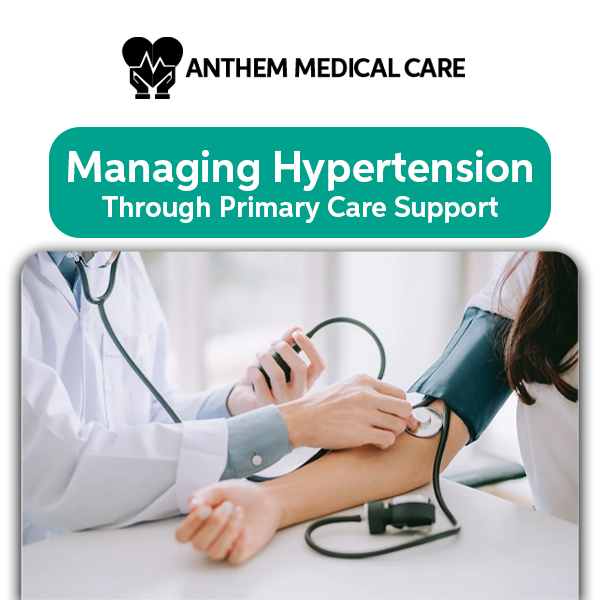High blood pressure affects nearly half of all American adults, yet many don’t realize they have it until serious complications arise. The condition silently damages your heart, blood vessels, and kidneys over years without obvious symptoms. That’s why regular monitoring and expert guidance from a trusted primary care provider makes all the difference in protecting your long-term health.
Understanding Your Blood Pressure Numbers
Blood pressure is shown as two numbers – both in mmHg. The first, your systolic pressure, reveals how strongly your blood pushes while your heart contracts. Consequently, the second, diastolic pressure, indicates the force against artery walls during relaxation between each heartbeat.
Healthy blood pressure is under 120/80. If it frequently hits 130/80 or more, that’s high blood pressure. Though those figures appear minor, they signal increasing stress on your heart and blood vessels with continued impact.
Why Primary Care Makes the Difference
Managing hypertension requires more than occasional doctor visits. Your primary care physician becomes your partner in health, tracking trends in your blood pressure, adjusting treatments as needed, and catching potential problems early.
Regular checkups with one doctor are better than seeing someone only when problems pop up. A consistent doctor learns about you, including your family, habits, and everything that impacts your health. Because they have the whole story, they can create a plan tailored just for you.
Keeping regular check-ins also builds commitment. Knowing a healthcare professional is following your journey boosts adherence to new habits and prescriptions. Furthermore, guidance from doctors clarifies what adjustments are necessary and why they benefit your well-being.
The Role of Lifestyle Modifications
It is possible to treat the high blood pressure with medication though lifestyle changes are the foundation of the treatment. Your primary care provider will indicate to you what changes will do the greatest good to you.
Eating is very important to blood pressure. Reduction of sodium to less than 2,300 mg per day and ideally 1,500 mg in case of a majority of hypertensive patients can reduce your readings by a few points. Increasing the number of potassium-rich foods such as fruits and vegetables will balance sodium. The DASH diet, based on whole grains and lean proteins with a lot of fruits and vegetables, is particularly efficient. Exercise also helps. Working out 30 minutes a day can reduce blood pressure by 5 to 8 mmHg. Safe exercises may be recommended by your doctor and may be in accordance with your fitness condition and any other health complications.
It is also important to control your weight. It only takes 5 to 10 pounds to make a significant reduction in blood pressure. Your primary care team can assist you to set achievable goals and provide you with support in the process. Stress also causes temporary increases in blood pressure, and exercises like deep breathing, meditation, or yoga can be used to ensure that blood pressure remains controlled. These are also helpful to the general well-being of the heart.
Medication Management and Monitoring
Some people require lifestyle modifications besides the use of drugs to achieve normal blood pressure. There are a number of drug classes that treat hypertension, each of which acts differently.
Diuretics assist the kidney to eliminate excess sodium and water, and this reduces the volume of blood. ACE inhibitors and ARBs dilate blood vessels through the regulation of hormone systems. Beta -blockers slow down the heart rate and decrease the power of each beat. The calcium blockers prevent calcium entry into the heart and vessel cells which allows the vessels to relax. It is not easy to find the correct medical treatment or combination. Your primary care provider will begin using one of them, observe your reaction and make changes. Certain patients might require weeks to experience the full effect and others might require the use of other drugs or varying doses before they reach their target blood pressure.
Frequent check-ups are useful to identify issues. Your physician will monitor side effects, drug interactions, and make sure that your treatment regimen remains effective.
Hypertension Treatment in Florida
Florida’s climate and lifestyle present unique considerations for managing hypertension. The heat and humidity mean you need to stay well hydrated, especially when exercising outdoors. Dehydration can affect blood pressure readings and how your body responds to certain medications.
The state’s diverse population means primary care providers here understand how hypertension affects different ethnic groups differently. African Americans face higher rates of severe hypertension and related complications, requiring particularly vigilant monitoring and sometimes more aggressive treatment approaches.
Access to fresh produce year-round in Florida makes it easier to follow heart-healthy eating plans. Local farmers markets offer abundant fruits and vegetables that support blood pressure management through natural nutrition.
Many Florida communities have walking trails, beaches, and parks that encourage physical activity. Your primary care team can help you take advantage of these resources while staying safe in warm weather.
The Importance of Consistent Follow-Up
Managing hypertension is a long-term commitment, not a one-time fix. Regular follow-up appointments allow your primary care provider to track your progress and make timely adjustments to your treatment plan.
During these visits, your doctor will check your blood pressure, review any symptoms or concerns, assess how well you’re following the treatment plan, and order tests to monitor your heart and kidney function. These appointments also provide opportunities to ask questions and get support for challenges you’re facing.
Home blood pressure monitoring between visits gives you and your doctor more complete information. Many people experience “white coat hypertension,” where readings spike in medical settings due to anxiety. Home readings provide a more accurate picture of your typical blood pressure throughout the day.
Your primary care provider will teach you proper monitoring techniques and help you understand when readings require immediate attention versus routine follow-up.
Preventing Complications Through Proactive Care
Uncontrolled hypertension damages your body gradually. High pressure strains artery walls, leading to tears where plaque can accumulate. This process increases your risk for heart attack, stroke, aneurysms, and kidney disease.
Proactive primary care catches and addresses rising blood pressure before it causes permanent damage. Regular screening tests monitor your heart function, kidney health, and blood vessel condition. Early intervention prevents or delays serious complications.
Your primary care team also addresses other risk factors that often accompany hypertension. High cholesterol, diabetes, and smoking all multiply cardiovascular risk when combined with elevated blood pressure. Comprehensive care tackles all these factors together for better outcomes.
Making Hypertension Management Sustainable
Sticking with a plan for managing hypertension long-term can feel overwhelming at first.. Your primary care provider helps make hypertension management fit into your daily life rather than dominate it.
Setting small, achievable goals creates momentum. Rather than overhauling your entire diet overnight, you might start by adding one serving of vegetables daily or switching to whole grain bread. These incremental changes add up to significant improvements without feeling impossible.
Your care team can connect you with resources like nutritionists, exercise programs, and support groups. Having people who understand your challenges makes the journey easier. Celebrating progress motivates continued effort. When your blood pressure drops or you reach a fitness goal, your primary care provider acknowledges these wins and encourages you to keep going.
Take Control of Your Blood Pressure Today
Living with hypertension doesn’t mean accepting limitations or complications. With proper support and management, most people with high blood pressure lead full, active lives while protecting their cardiovascular health.
Your primary care provider offers the consistent, personalized attention that makes managing hypertension successful. Regular monitoring, treatment adjustments, lifestyle guidance, and early intervention for complications all happen through this ongoing relationship.
Don’t wait for symptoms to appear. Hypertension rarely causes noticeable signs until it’s already damaged your body. Getting your blood pressure checked and establishing care with a primary care physician protects your health now and for years to come.
Ready to take control of your blood pressure? Schedule an appointment with our primary care team to begin your journey toward better cardiovascular health. We’ll work with you to create a personalized plan that fits your life while keeping your blood pressure in a healthy range.








